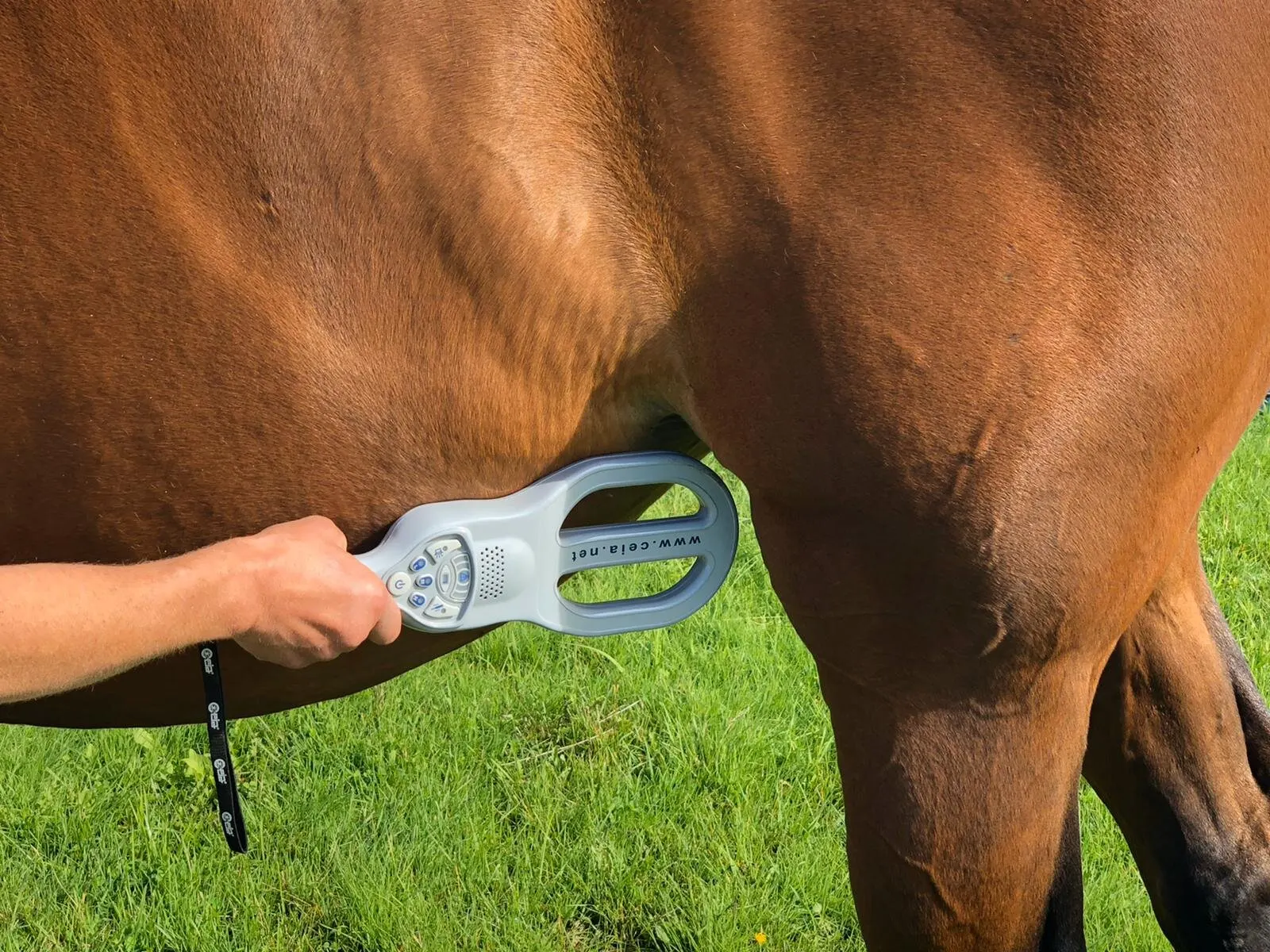Olivia Schlichting, DVM, is a small animal veterinarian who breeds sport horses and rides with the Warrenton Hunt (Virginia). In 2019, 5-year-old Kat was Schlichting’s mount for hunting throughout the fall and winter. While many mares’ cycles cease during the colder months, Kat’s didn’t. And when she was in heat, Schlichting recalled, “Her behavior became totally different.”
The normally sensible young horse became “kicky” and “spooky,” Schlichting said. When a veterinarian palpated Kat’s ovaries, “She just about dropped to the floor. So I don’t think it was just that she was hormonal. I think she was actually painful,” said Schlichting.
Most mares don’t experience such severe symptoms—or other problems like distractibility, reactivity to other horses and decreased cooperation under saddle—during their cycles, but some do. Schlichting considered the conventional options for providing Kat some relief.
The most common approach is administering altrenogest, a synthetic version of the hormone progesterone, via an oral syringe or on top of the mare’s food each day. The hormone, often called by the brand name Regu-Mate, must be dispensed with care since studies have shown that progesterone can be absorbed via direct skin contact by humans who administer the medication, which can lead to disrupted menstrual cycles. The substance can also pass into groundwater when feed bowls are cleaned and rinsed.
“I really didn’t want to handle the Regu-Mate,” Schlichting said.

Another option she considered was placing an intrauterine glass marble. Touted for a while as a way to stop cycling by inducing a false or pseudo-pregnancy, they were often ejected and occasionally caused uterine injury by breaking.
“I have heard more cases of the poor mare having the most horrible infection—to the point where her fertility could be permanently gone—because the marbles chip, and then the chips work their way into the wall of the uterus,” Schlichting said.
The marbles can also be difficult to detect via ultrasound, she pointed out. If a mare has changed hands, her owner might not even be aware that a marble had been inserted.
Removing Kat’s ovaries was another option that didn’t appeal to her owner.
“When you remove the ovaries, you’re removing the hormones. You’re not putting a beneficial hormone in there,” Schlichting said. “You won’t necessarily get the same effect by removing the ovaries, and it’s permanent. That’s not a great service for the mare, because if she ever becomes unsound in limb, she won’t have the opportunity to be a broodmare.”
Luckily for Kat, a new product had just hit the market.
Enter The Pearl Pod
Seeking a better solution for mares like Kat, University of Massachusetts at Amherst researcher and veterinarian Carlos Gradil, DVM, MS, Ph.D., DACT, began developing a prototype for a novel intrauterine device around 2014.
After peer-reviewed studies validated the safety and effectiveness of the new device, Gradil began marketing his invention.
ADVERTISEMENT

Schlichting heard about the Pearl Pod and was intrigued. “This was a scientific alternative that was actually researched and developed to do what it was supposed to do,” she said.
Even though the device had just become available, Schlichting felt comfortable moving ahead. “So I had it put in, and she was great. It fools their body into thinking that they’re pregnant,” she said. “And anybody will tell you that a pregnant mare is much easier to deal with than a cycling mare.”
While response to Gradil’s device has been positive, production bottlenecks have interrupted the supply of Pearl Pods for the past year. But Gradil sees a light at the end of the tunnel: Soon the device should again be available for purchase by veterinarians. Could it be right for your mare?
How It Works
The Pearl Pod consists of three elliptical plastic-coated magnets slightly over 1 inch long and half an inch wide. After the three pieces are inserted into the mare’s uterus with an applicator tube, the north and south poles of each magnet cause the pieces to self-assemble into a ring configuration.
Together, the three magnets are large enough to be retained within the mare’s body, Gradil explained, while their smooth surface and rounded shape minimize inflammation and the potential for infection.
The presence of the device can be confirmed by ultrasound, a magnetic detector or even an iPhone. And when the time comes to remove the Pearl Pod, a magnet suspended on a length of filament captures the device and causes the individual units to line up in a row. The Pearl Pod can then be withdrawn by pulling gently on the filament.
Like other intrauterine devices, the Pearl Pod works by simulating pregnancy.
“This IUD gives that signal to the mare, and she believes she is pregnant,” Gradil said. Her body releases more of the hormone progesterone, which prevents the heat cycle from beginning again, creates the right conditions for the growing embryo within the uterus and tightens the cervix.
“Instead of you giving the mare something [like Regu-Mate], the mare will produce her own progesterone,” Gradil said.
While the Pearl Pod is a hormone- and copper-free device, current research is investigating how those additions might be beneficial in certain uses.
Risks And Cautions
The most significant risk associated with the use of the Pearl Pod is pelvic infection. For that reason, Gradil emphasized that the device should not be used in mares with a current pelvic infection or a history of pelvic infections. Additionally, maintaining sterile conditions during insertion is critical.
Although some mares may continue to experience heat cycles after receiving a Pearl Pod, that’s not necessarily a bad thing, Gradil said.
“Because when [the mares] re-cycle, if there’s any infection, they clear themselves out,” Gradil explained. “Some mares [using the Pearl Pod], they come into estrus, but the estrus is more mild. They are in estrus, but the behavior is much more ameliorated.”
ADVERTISEMENT

Mares with gynecological cancers (including granulosa cell tumors of the ovary) are not candidates for the device. Pregnancy also should be ruled out prior to insertion.
In studies, the Pearl Pod was removed five to seven months after its placement, with a period of non-use before reinsertion. That schedule remains the recommended practice. But with manufacturing delays interrupting the availability of the device over the past year, Gradil said, some veterinarians have opted to leave the Pearl Pod in place longer. While there are no studies to indicate whether effectiveness declines with longer use, Gradil believes the practice should be safe with ongoing monitoring of the mare.
Devices removed from mares after 18 months show no changes compared to new devices, he said. The neodymium magnets at the devices’ cores lose about 15% of their strength over the course of a century, but that rate of decline isn’t significant within the lifespan of a horse.
Gradil said the 500 or so Pearl Pod devices he has sold have generally outperformed expectations among the veterinarians who have used them, and he fields near-daily inquiries from prospective users around the world.
When it comes into stock, the Pearl Pod will be available as a kit containing three pieces along with an application and retrieval device. Only licensed veterinarians may purchase the kit or individual pods, and a veterinarian should insert the device and oversee its use.
With insertion and monitoring, a year’s use of the Pearl Pod should be comparable in price to an oral hormone supplement such as Regu-Mate, Gradil said.
Back On The Farm
Schlichting said the Pearl Pod managed her mare’s symptoms and behavior for about two years. But when she listed the horse for sale, several potential buyers were concerned about the device’s presence.
“I would have people contacting me about buying her,” Schlichting recalled. “They would find out that she had an IUD in place, and they would say, ‘Oh, I don’t want to deal with that.’ And they wouldn’t even look at her.”
While marketing Kat, Schlichting noticed that the mare’s behavior changed again. An ultrasound revealed that the Pearl Pod had been expelled. Kat resumed cycling, and some of her earlier spookiness returned.
“I could tell that she was a little spooky when she was in heat, but she didn’t seem to be painful anymore. So I think she kind of outgrew that,” Schlichting said. Kat went to her new home without an intrauterine device in place.
Schlichting was glad to hear that Pearl Pods will soon be available for purchase again.
“We have three 3-year-old fillies coming up,” she said. “Once they go under saddle, we may very well put those in them, because I would much rather do that than give them artificial hormones.”
This article originally appeared in the September 2023 issue of The Chronicle of the Horse. You can subscribe and get online access to a digital version and then enjoy a year of The Chronicle of the Horse and our lifestyle publication, Untacked. If you’re just following COTH online, you’re missing so much great unique content. Each print issue of the Chronicle is full of in-depth competition news, fascinating features, probing looks at issues within the sports of hunter/jumper, eventing and dressage, and stunning photography.














